catch & release
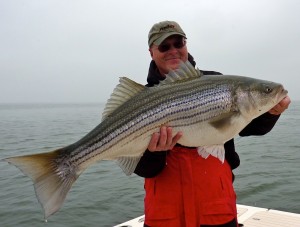 I don’t know a single fishermen who hasn’t lost the biggest fish of their life. Everyone knows the big one always gets away, right? Nevertheless, anglers are eternal optimists. Most of us aren’t out to catch another fish the same size as the last one. We expect the next one to be a lot bigger. I don’t know about you, but I’m forever certain the world record is waiting to swallow my lure on my next cast. Since the strike-outs keep us going, I guess we should plan for them. Here are eight sure-fire tips to guarantee that fish-of-a-life-time gets away. I’ve tested each one so I know they work!
I don’t know a single fishermen who hasn’t lost the biggest fish of their life. Everyone knows the big one always gets away, right? Nevertheless, anglers are eternal optimists. Most of us aren’t out to catch another fish the same size as the last one. We expect the next one to be a lot bigger. I don’t know about you, but I’m forever certain the world record is waiting to swallow my lure on my next cast. Since the strike-outs keep us going, I guess we should plan for them. Here are eight sure-fire tips to guarantee that fish-of-a-life-time gets away. I’ve tested each one so I know they work!
Tip #1 – Don’t retie after a big fish. It’s a waste of time. Just pat yourself on the back and cast again because it’s a sure bet that your next strike will be from a fish twice as big and there’s nothing more satisfying than standing on the bow with a slack line watching your world record swim off into the sunset. Read More!
 If you’ve looked down at the water flowing beneath the Chesapeake Bay Bridge recently you’ve surely noticed that it’s the color of butterscotch syrup. According to the Maryland Department of Natural Resources, the flow over the Conowingo Dam on March 12 was the highest since Tropical Storm Ivan in 2004. Water clarity is worse than it’s been in recorded history. We’re currently experiencing an annual event called the freshet. Although I never heard the term before I moved to this region, I now know that a freshet occurs in saltwater estuaries when spring rains and snow-melt cause upstream rivers to flood. This results in the additional flow of hundreds of billions of gallons of muddy, sediment-saturated water into the Bay. The map on the left is a NASA satellite photo of the Chesapeake region taken this week. I’ve labeled a few places for reference. It shows a plume of muddy water flowing from the Susquehanna River south though the main stem of the Bay to the mouth of the Potomac River. Note that the water is muddiest in the area between the Susquehanna Flats and the Bay Bridge.
If you’ve looked down at the water flowing beneath the Chesapeake Bay Bridge recently you’ve surely noticed that it’s the color of butterscotch syrup. According to the Maryland Department of Natural Resources, the flow over the Conowingo Dam on March 12 was the highest since Tropical Storm Ivan in 2004. Water clarity is worse than it’s been in recorded history. We’re currently experiencing an annual event called the freshet. Although I never heard the term before I moved to this region, I now know that a freshet occurs in saltwater estuaries when spring rains and snow-melt cause upstream rivers to flood. This results in the additional flow of hundreds of billions of gallons of muddy, sediment-saturated water into the Bay. The map on the left is a NASA satellite photo of the Chesapeake region taken this week. I’ve labeled a few places for reference. It shows a plume of muddy water flowing from the Susquehanna River south though the main stem of the Bay to the mouth of the Potomac River. Note that the water is muddiest in the area between the Susquehanna Flats and the Bay Bridge.
Although the freshet occurs every spring, there is more flow in some years than others. During an average year, about two and a half billion pounds of sediment wash down the Susquehanna into the Bay. In very wet years it can be twice that. It remains to be seen how this spring will turn out, but for now things are above normal. Since there is research proving striped bass spawn more productively in fresher water, the news is both good and bad for fishing. Read More!
It’s been a snowy week here on Kent Island. We’re still digging out as one cold front after another sweeps across the mid-Atlantic. With more snow in the forecast, it looks we’ll be hard-pressed to get in many catch & release striper trips in the near future. 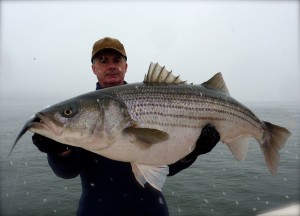 Fortunately, I was able to get out for a few hours this snowy weekend. I had planned to launch my center console Thunder Road, but my neighbor Mark called to say he was up for a trip if we wanted to go in his Parker. That was a no-brainer since he has a heated cabin. My buddy Jamie joined us. As thunder rumbled across the Chesapeake Bay, we broke through the ice at Queen Anne Marina and set off into the fog, rain, and snow. I’ll let the video tell the story with the caveat that jigging is very much a hit or miss enterprise this time of year. Just because fish are there one day doesn’t mean they will be the next. The best bet is to fish locations where the fish can find warmer water. Here’s the video report:
Fortunately, I was able to get out for a few hours this snowy weekend. I had planned to launch my center console Thunder Road, but my neighbor Mark called to say he was up for a trip if we wanted to go in his Parker. That was a no-brainer since he has a heated cabin. My buddy Jamie joined us. As thunder rumbled across the Chesapeake Bay, we broke through the ice at Queen Anne Marina and set off into the fog, rain, and snow. I’ll let the video tell the story with the caveat that jigging is very much a hit or miss enterprise this time of year. Just because fish are there one day doesn’t mean they will be the next. The best bet is to fish locations where the fish can find warmer water. Here’s the video report:
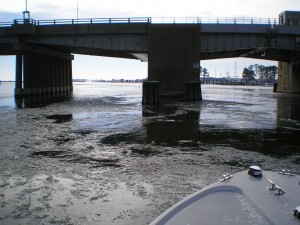 Catching striped bass in winter on the Chesapeake Bay isn’t easy. It’s not that the fish aren’t around because there are some to be caught. It’s just that it’s very hard to get to them. We’ve had an exceptionally cold December followed by multiple sub-freezing days in January. It’s also been very windy. The windows of light-tackle opportunity are frosted. Even on rare days when the weather is fishable it’s a challenge to get on the water because the boat launches around Kent Island have been iced in solid. Fortunately, we got a little warming trend this week, so a few ramps opened up. Read More!
Catching striped bass in winter on the Chesapeake Bay isn’t easy. It’s not that the fish aren’t around because there are some to be caught. It’s just that it’s very hard to get to them. We’ve had an exceptionally cold December followed by multiple sub-freezing days in January. It’s also been very windy. The windows of light-tackle opportunity are frosted. Even on rare days when the weather is fishable it’s a challenge to get on the water because the boat launches around Kent Island have been iced in solid. Fortunately, we got a little warming trend this week, so a few ramps opened up. Read More!
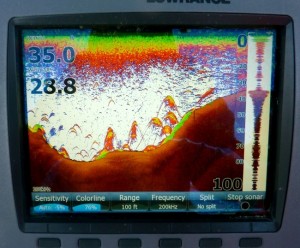 To fizz or not to fizz, that is the question a lot of yellow perch fishermen have been asking lately. As you can see by this sonar shot, yellow perch can hold in a wide range of depths this time of year in the Chesapeake Bay. At issue is that a few of the fish we catch from the deepest water come up with distended swim bladders. Since we inevitably land a few that are under the legal size limit, they have to be released. Because of all the air in their bodies, they can’t always swim back down. This leaves them floating on top of the water where they are vulnerable to birds and other predators. The practice of puncturing a fishes swim bladder with a hypodermic needle or other sharp object to relieve pressure is called fizzing. It works for some species, but for others it isn’t such a good idea. What about yellow perch? This week, I put the question to the experts. I spoke with several fisheries biologists I know, including some at the Maryland Department of Natural Resources. Here’s what I learned. Read More!
To fizz or not to fizz, that is the question a lot of yellow perch fishermen have been asking lately. As you can see by this sonar shot, yellow perch can hold in a wide range of depths this time of year in the Chesapeake Bay. At issue is that a few of the fish we catch from the deepest water come up with distended swim bladders. Since we inevitably land a few that are under the legal size limit, they have to be released. Because of all the air in their bodies, they can’t always swim back down. This leaves them floating on top of the water where they are vulnerable to birds and other predators. The practice of puncturing a fishes swim bladder with a hypodermic needle or other sharp object to relieve pressure is called fizzing. It works for some species, but for others it isn’t such a good idea. What about yellow perch? This week, I put the question to the experts. I spoke with several fisheries biologists I know, including some at the Maryland Department of Natural Resources. Here’s what I learned. Read More!
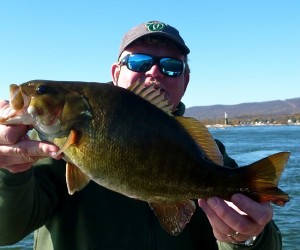 I had to pull a night shift at work this week, so I decided to reset my circadian clock with an early morning of smallmouth fishing on the Susquehanna river. Last July, I invited Bill Montgomery to join me for a Chesapeake Bay top-water striper trip near Poplar Island. Bill and I hit it off after finding we shared interests in both fishing and acoustic music. Bill returned my fishing favor by inviting me up to Pennsylvania to see one of his favorite bass spots. He fishes occasionally with his friend Dennis Mongold who is a smallmouth bass guide specializing in this section of the Susquehanna. I met them near Harrisburg where we loaded up in Dennis’s custom made aluminum jon-boat. The boat is specially outfitted for fishing this section of the rocky river. Dennis has his jet-drive outboard mounted on a hydraulic lift so he can adjust the draft for very shallow water. The bottom of the boat is coated with hard plastic so it can easily skim over the rocks. I’ve done a lot of river fishing, but this is the first time I’ve been on a boat running thirty miles per hour in four inches of water. I admit I was a little unnerved! Read More!
I had to pull a night shift at work this week, so I decided to reset my circadian clock with an early morning of smallmouth fishing on the Susquehanna river. Last July, I invited Bill Montgomery to join me for a Chesapeake Bay top-water striper trip near Poplar Island. Bill and I hit it off after finding we shared interests in both fishing and acoustic music. Bill returned my fishing favor by inviting me up to Pennsylvania to see one of his favorite bass spots. He fishes occasionally with his friend Dennis Mongold who is a smallmouth bass guide specializing in this section of the Susquehanna. I met them near Harrisburg where we loaded up in Dennis’s custom made aluminum jon-boat. The boat is specially outfitted for fishing this section of the rocky river. Dennis has his jet-drive outboard mounted on a hydraulic lift so he can adjust the draft for very shallow water. The bottom of the boat is coated with hard plastic so it can easily skim over the rocks. I’ve done a lot of river fishing, but this is the first time I’ve been on a boat running thirty miles per hour in four inches of water. I admit I was a little unnerved! Read More!



